Window tinting for cars has become increasingly popular in recent years, and for good reason. Tinted windows not only give your car a sleek and stylish look, but they also provide a host of benefits that can make your driving experience safer and more comfortable. In this article, we’ll take a closer look at the advantages of window tinting, the different types of tinting available, and what you need to know before getting your windows tinted.
Advantages of Window Tinting
One of the primary benefits of window tinting is the protection it provides against harmful UV rays. These rays can not only damage your skin, but they can also cause the interior of your car to fade and crack over time.
Tinted windows can block up to 99% of these rays, keeping you and your car’s interior safe and protected.
Another advantage of window tinting is the increased privacy it provides. Tinted windows make it more difficult for people to see inside your car, which can be a deterrent against theft and break-ins. Tinting also provides a level of privacy for you and your passengers, making it more difficult for people to see you or your belongings while you're inside the car.
Tinted windows can also make your driving experience more comfortable by reducing the amount of heat that enters your car. This can be especially beneficial during hot summer months when the sun can make the inside of your car feel like an oven. Tinted windows can also reduce glare from the sun, making it easier to see while driving and reducing eye strain.
Types of Window Tinting
There are several different types of window tinting available, each with its own benefits and drawbacks. The most common types of tinting are:
1. Dyed Window Tinting: this type of tinting is made by layering a thin film of dyed polyester over the inside of the window. Dyed tinting provides good UV protection and privacy, but it can fade and discolor over time.
2. Metalized Window Tinting: metalized tinting uses tiny metallic particles to reflect heat and block UV rays. This type of tinting provides good heat reduction and UV protection, but it can interfere with radio and GPS signals.
3. Ceramic Window Tinting: Ceramic tinting uses nano-ceramic particles to block heat and UV rays. This type of tinting provides excellent heat reduction and UV protection without interfering with radio and GPS signals.
4. Hybrid Window Tinting: hybrid tinting combines the benefits of dyed and metalized tinting, providing good heat reduction, UV protection, and privacy without interfering with radio and GPS signals.
Choosing the right type of tinting will depend on your specific needs and preferences, as well as your budget.
What You Need to Know Before Tinting Your Windows
Before getting your windows tinted, there are a few things you need to know. First, you need to check your state’s laws regarding window tinting. Some states have restrictions on how dark your windows can be tinted, so make sure you’re in compliance with the law.
You’ll also want to make sure you choose a reputable window tinting company with experienced technicians who use high-quality materials. Look for a company that offers a warrant on their work, and ask to see examples of their previous work before committing.
Lastly, be prepared to invest in your window tinting. WHile there are DIY kits available, it’s generally the best to have a professional do the job. The cost of professional window tinting will depend on the size of your car, the type of tinting you choose, and the company.












0 Comments